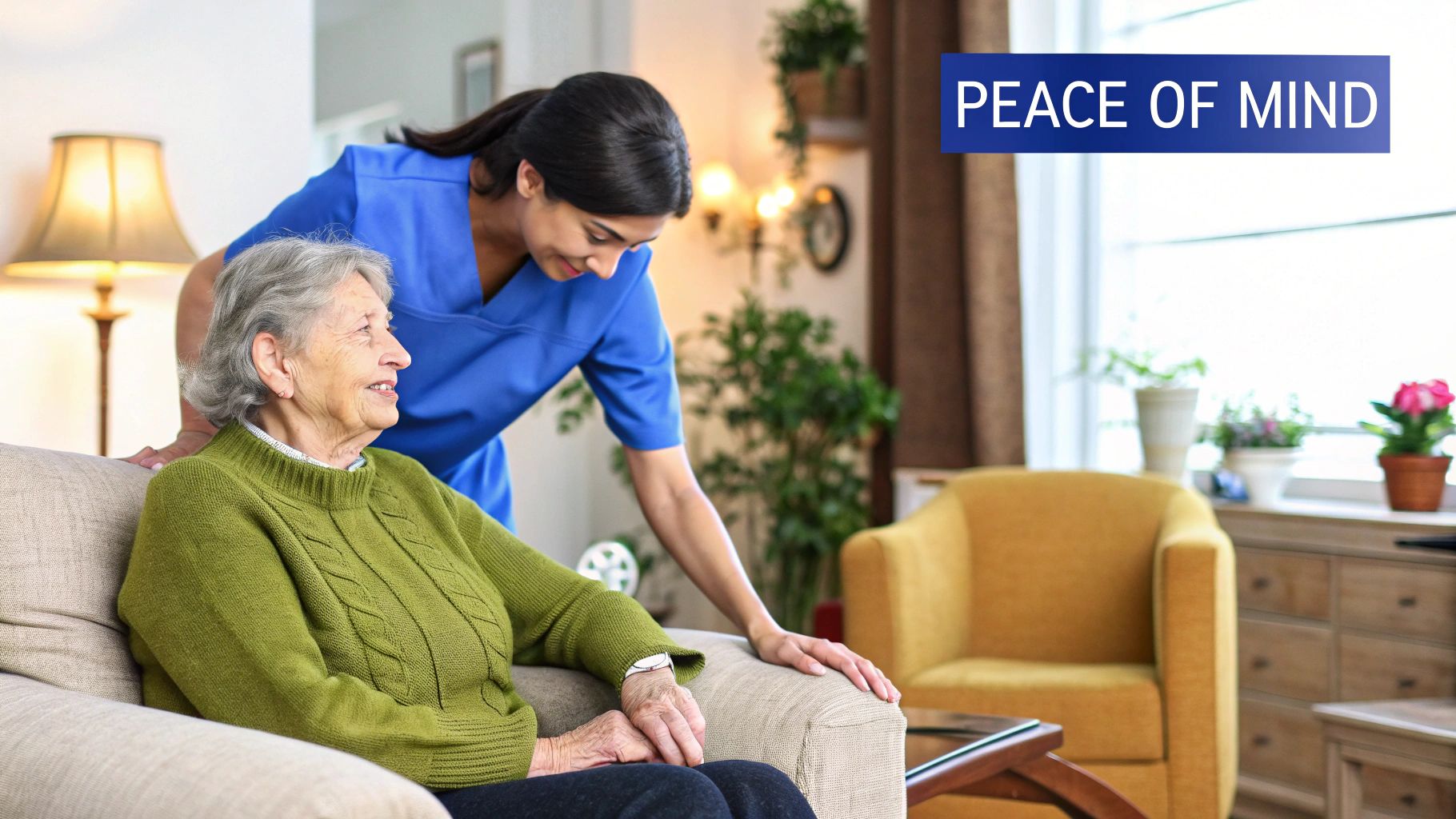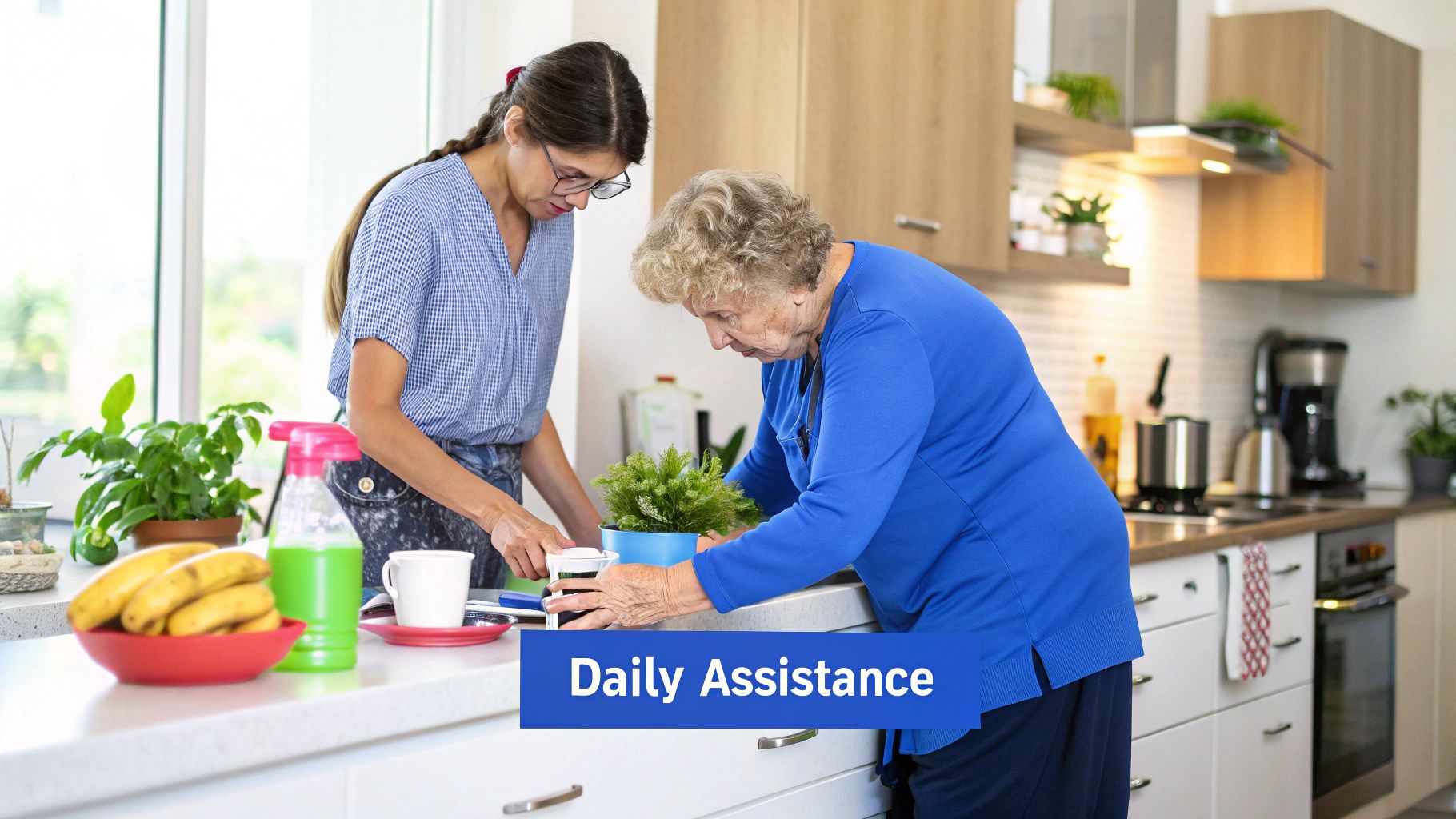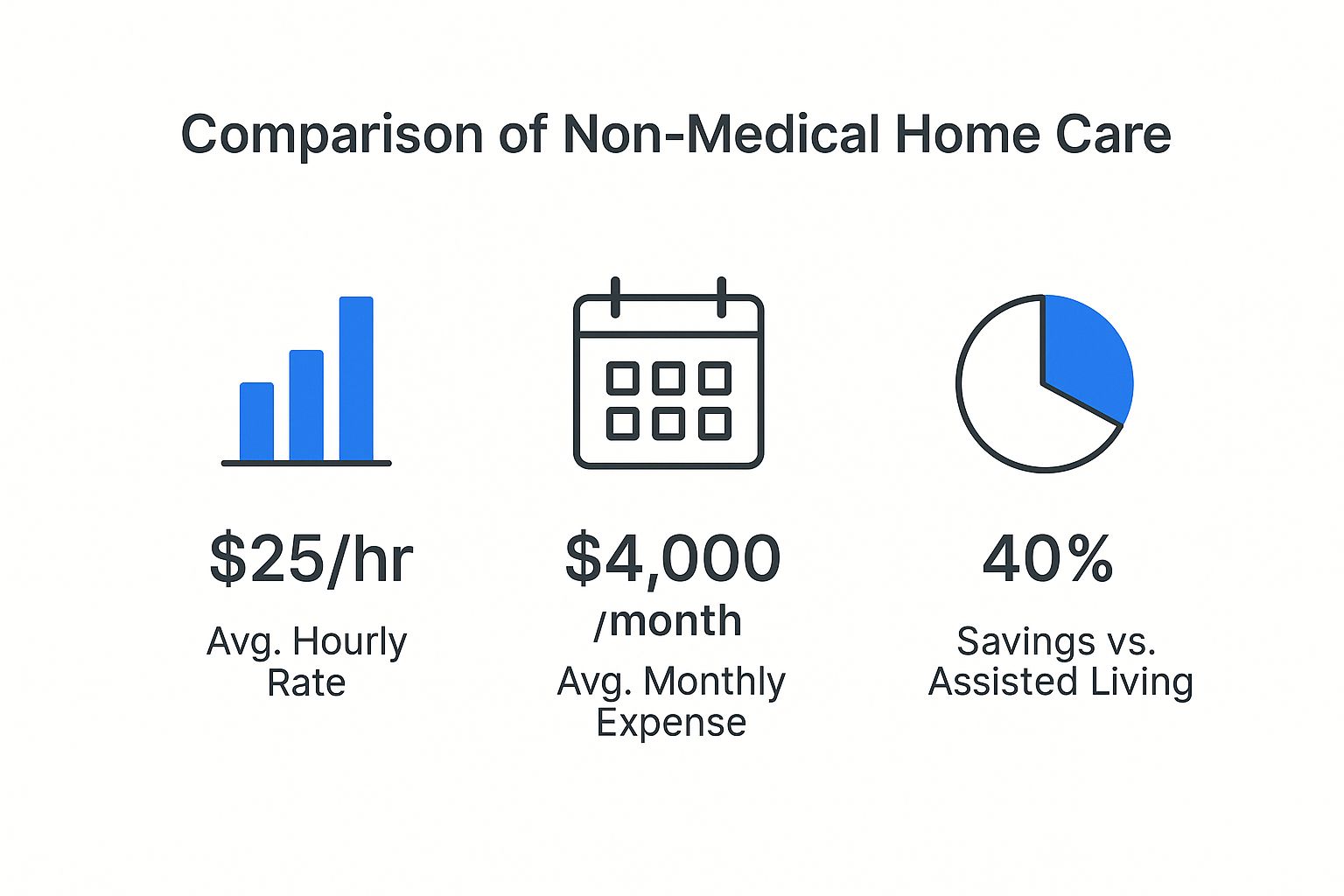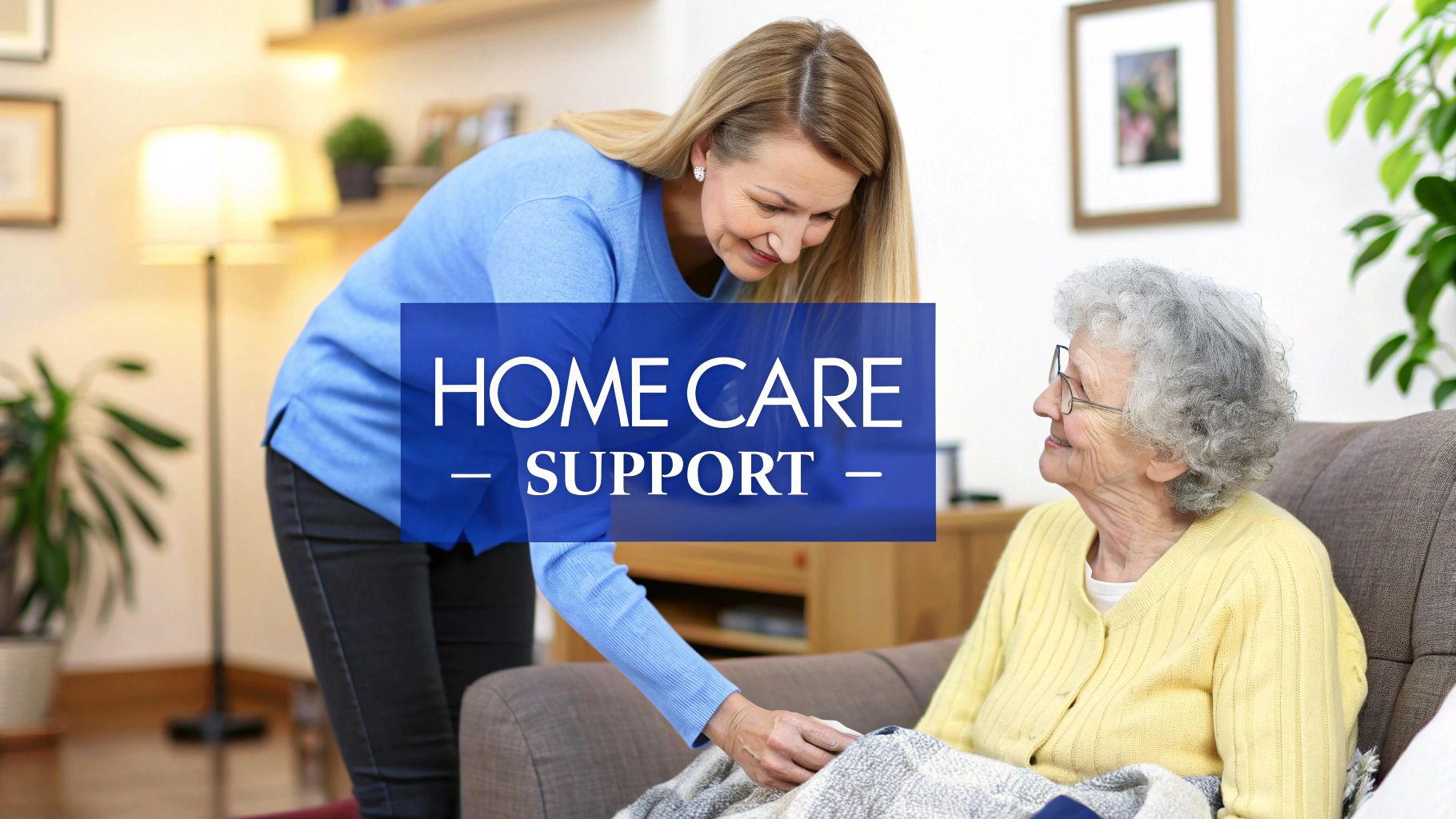When someone you care about is recovering from an illness, getting older, or just needs a little extra help to stay safe at home, the day-to-day stuff can suddenly feel overwhelming. Simple things we take for granted—like fixing a meal, keeping the house tidy, or even just getting dressed in the morning—can become major hurdles.
This is exactly where non medical home care comes in. It’s not about nurses, needles, or prescriptions. Instead, it’s about providing genuine, hands-on support and companionship that makes life easier, safer, and more enjoyable.
What Is Non Medical Home Care Really?
Think of a non-medical caregiver as a helping hand, a friendly face, or an extension of your own family. Their whole purpose is to help with the practical, everyday needs that keep a household running and a person feeling independent.
This type of care is built on a foundation of support and well-being. It’s about making sure the laundry gets done, there’s a nutritious meal on the table, and your loved one has someone to share a conversation with. It’s about preserving dignity and quality of life right where they feel most comfortable: home.
The Core Difference From Medical Care
It's easy to get non-medical home care confused with medical home health care, but they serve two very different—though equally important—roles.
Medical home health care is clinical. It’s prescribed by a doctor and delivered by licensed professionals like registered nurses, physical therapists, or occupational therapists. They handle tasks like wound care, physical therapy, injections, and monitoring serious health conditions.
Non-medical home care, on the other hand, is all about supporting independence by helping with what experts call Activities of Daily Living (ADLs) and Instrumental Activities of Daily Living (IADLs).
- Activities of Daily Living (ADLs): These are the absolute basics of self-care—the things we have to do every day to get by. Think bathing, dressing, grooming, using the toilet, and moving around safely.
- Instrumental Activities of Daily Living (IADLs): These are the tasks that allow someone to live independently in their home. This includes things like preparing meals, light housekeeping, running errands, managing transportation, and remembering appointments.
The goal of non medical home care isn’t to cure an illness. It's to create a safe, supportive, and engaging environment that allows a person to thrive. It perfectly bridges the gap between being completely on your own and needing to move into a facility.
To make this distinction crystal clear, let's look at them side-by-side.
Non Medical Home Care vs Medical Home Health Care
| Feature | Non Medical Home Care | Medical Home Health Care |
|---|---|---|
| Primary Goal | Support daily living, companionship, and safety. | Treat illness or injury; provide skilled medical services. |
| Who Provides It | Professional caregivers, home health aides, companions. | Registered Nurses (RNs), Physical Therapists (PTs), etc. |
| Is a Doctor's Order Needed? | No, it's arranged directly by the family. | Yes, it must be prescribed by a physician. |
| Typical Services | Meal prep, housekeeping, personal care, errands, companionship. | Wound care, injections, medication administration, therapy. |
| Payment Sources | Primarily private pay, some long-term care insurance. | Medicare, Medicaid, private health insurance. |
| Duration of Care | Can be long-term, ongoing for months or years. | Typically short-term, for recovery after a hospital stay. |
As you can see, one is focused on living, while the other is focused on healing. Both are vital, but they meet different needs.
An Analogy to Bring It All Home
Still a bit fuzzy? Think of it like maintaining a car.
Your mechanic is the medical professional. They handle the complex stuff—fixing the engine, running diagnostics, and making sure the critical systems are working properly. You can't have a functioning car without them.
The non-medical caregiver is like a trusted driver's assistant. They make sure the car has gas, keep it clean, and help you navigate the route safely so you can get where you need to go without any trouble.
Both are essential for a successful journey. In the same way, non-medical care often works hand-in-hand with medical treatments to create a complete support system, allowing life to continue with comfort, dignity, and peace of mind.
The Full Spectrum of In-Home Care Services

The phrase “non medical home care” actually covers a surprisingly wide range of services, all designed to be flexible and adapt as a person's needs change. It’s not a one-size-fits-all package but a custom toolkit meant to help someone maintain their independence and quality of life right where they're most comfortable.
You can think of these services as building blocks. They can be stacked and arranged in whatever combination makes the most sense for your family, creating a support system that feels just right. These services typically fall into three main categories, each one tackling a different aspect of daily life.
Companion Care Fostering Connection
Social isolation is a major health risk for older adults, often leading to higher rates of depression and cognitive decline. Companion care is the direct answer to this problem, providing social engagement and a consistent, friendly face. It’s about so much more than just having someone in the house; it's about building a genuine relationship.
A companion caregiver is there to support a person's emotional and social well-being. They can become a trusted friend for conversation, a partner for hobbies, or simply a comforting presence that breaks up the long, quiet hours of the day.
This type of care often includes:
- Engaging in Conversation: Sharing stories, talking about current events, or just being a good listener.
- Participating in Hobbies: Playing cards, working on puzzles, tending to a garden, or listening to music together.
- Reading Aloud: Enjoying books and newspapers with someone who might have trouble with their vision.
- Accompanying on Outings: Attending community events, visiting with friends, or simply taking a walk in the park.
For instance, a caregiver might spend afternoons with a client who adores old movies, watching classics and reminiscing. This simple activity provides vital mental stimulation and wards off the loneliness that can so easily take hold.
Homemaker Services Keeping the Home Safe and Comfortable
A clean, organized home is fundamental to good health, but keeping up with daily chores can become physically overwhelming. Homemaker services provide the practical, hands-on help needed to keep a household running smoothly. This support removes the physical burden of home maintenance, which reduces the risk of falls and ensures a safe, comfortable living space.
These services manage the instrumental activities of daily living (IADLs) that are so important for maintaining independence.
By taking over the practical tasks, a homemaker service frees up a senior’s energy to focus on what truly matters—whether that’s time with family, pursuing a hobby, or just resting comfortably.
Common homemaker services include:
- Meal Planning and Preparation: Making sure nutritious, balanced meals are always available, and catering to any dietary needs.
- Light Housekeeping: Dusting, vacuuming, mopping floors, and keeping the kitchen and bathrooms clean.
- Laundry and Linens: Washing, drying, folding clothes, and changing bed linens.
- Shopping and Errands: Picking up groceries, prescriptions, and other necessities.
- Organization: Keeping closets and pantries tidy to minimize clutter and potential fall hazards.
Think about someone recovering from surgery. A caregiver could come in to prepare healthy meals for the week, do a load of laundry, and make sure all the walkways are clear. This allows the person to recover without stress or the risk of another injury. This is a core function of non medical home care.
Personal Care Assisting with Dignity
Personal care is the most hands-on level of support, offering direct help with activities of daily living (ADLs). Because these tasks are so personal, they are always handled with the utmost respect for a person's dignity and privacy. In fact, more than 26% of people over age 60 report having some difficulty with these fundamental tasks.
A professional caregiver is trained to provide this kind of assistance in a way that feels empowering, not embarrassing. They help clients maintain their personal hygiene and routines, which is crucial for both physical health and self-esteem.
Personal care services focus on:
- Bathing and Showering Assistance: Ensuring safety and comfort in the bathroom.
- Dressing and Grooming: Helping with clothing choices, buttons, zippers, shaving, and hair care.
- Mobility Assistance: Providing a steady arm for walking, helping transfer from a bed to a chair, and repositioning to prevent bedsores.
- Toileting and Incontinence Care: Offering discreet and respectful help when it's needed most.
These three pillars—companionship, homemaking, and personal care—are the foundation of non medical home care. They can be mixed, matched, and adjusted over time to create a truly personalized plan that supports a loved one's desire to live safely and happily at home.
Why In-Home Support Is More Important Than Ever

The growing demand for in-home support isn’t just some passing trend. It’s a genuine response to major shifts in our society and a reflection of a deeply human desire to stay in a comfortable, familiar place. A couple of powerful forces are behind this increasing need for non medical home care services across the country.
First off, the demographics are changing. Fast. The U.S. population is aging, and that simple fact is reshaping our communities and how we approach care. More families than ever are looking for compassionate, sustainable ways to support their parents and grandparents as they get older.
This demographic wave means we need better systems for home-based support. As the number of seniors grows, so does the need for services that help them manage daily life safely, especially if they're dealing with chronic conditions. It's no surprise the industry is booming to meet this demand, with projections expecting it to generate over $107 billion in revenue by 2025. This isn't just a business trend; it's a direct answer to a real human need. You can get more insights on the future of home-based healthcare to see just how significant this shift is.
The Powerful Desire to Age in Place
But it’s not just about the numbers. There’s a profound emotional element here, too. The vast majority of older adults want the same thing: the ability to age in place. They want to live out their years in their own homes, surrounded by cherished memories, familiar routines, and a real sense of belonging.
A home is so much more than just four walls and a roof. It's a sanctuary of comfort, identity, and security. The thought of leaving it behind for an institution can feel like giving up independence and control, which is why so many people resist the idea.
The concept of "aging in place" isn't just about a physical location. It’s about preserving dignity, autonomy, and the quality of life that comes from being in an environment you know and love. Non medical home care is the essential bridge that makes this preference a safe, realistic option for millions.
How In-Home Care Makes It Possible
This is where the real value of non medical home care shines. It directly tackles the challenges that might otherwise force someone to move out of their beloved home. By providing targeted, personalized support, caregivers empower seniors to hold onto their independence safely.
Here’s a look at how this support makes a tangible difference:
- Enhancing Safety: A caregiver can spot and reduce fall risks, make sure meals are prepared safely, and offer a steady arm for getting around. They help turn a potentially hazardous environment into a secure one.
- Providing Peace of Mind: For adult children, knowing a professional is checking in, helping with daily tasks, and offering companionship brings immense relief. It helps prevent caregiver burnout and lets you focus on being a son or daughter again.
- Supporting Independence: A good caregiver doesn't take over. Instead, they support a person’s ability to keep doing things for themselves, stepping in only where help is truly needed.
By filling in the gaps with reliable, compassionate assistance, this kind of support transforms the desire to age in place from a hopeful wish into a practical reality. It allows families to honor their loved one’s wishes while ensuring their well-being is always the top priority. This perfect alignment of personal preference and practical need is exactly why in-home support has become such a crucial part of modern senior care. For more information on how our services support families, you can check out our guide on caregiving solutions.
Key Benefits for Seniors and Their Families

Deciding to bring professional support into the home creates a positive ripple effect. It's a choice that touches not just the senior receiving care but their entire family network. Think of non-medical home care as more than a list of services; it's a profound shift that boosts well-being, helps restore relationships, and delivers invaluable peace of mind for everyone.
For seniors, the benefits are deeply personal—they revolve around dignity, independence, and the simple comfort of living life on their own terms. For families, the relief is just as powerful. It reduces stress and allows them to reconnect with their loved ones in a more meaningful way, without the constant pressure of being the sole caregiver.
Enhancing Life for Seniors
For most seniors, the single greatest benefit is the ability to stay in their own cherished home. It’s the place filled with memories, familiar routines, and a sense of control. Non-medical home care provides the safety net that makes this possible.
But this support goes far beyond just getting daily tasks done. It’s about empowering seniors to live with confidence and joy.
- Maintaining Independence: A caregiver doesn't take over; they assist. This simple distinction allows a senior to keep making their own choices—from what to eat for breakfast to how they spend their afternoon—preserving their autonomy.
- Personalized, One-on-One Attention: In a facility, staff must divide their time among many residents. In-home care is different. It’s completely focused on one person, ensuring their needs are met right away and a strong, trusting relationship can be built.
- Combating Loneliness: Social isolation is a serious health risk for older adults. A companion caregiver provides consistent conversation, shared activities, and a friendly face, which is absolutely vital for mental and emotional health.
The core value of non-medical home care is that it adapts to the person, not the other way around. It honors their history, respects their preferences, and supports their desire to live a full and engaged life.
The demand for these services is skyrocketing, which has put a spotlight on a significant caregiver shortage. In states like Massachusetts, it's estimated there will be only 22 caregivers for every 1,000 residents needing care by 2025. This highlights just how critical companion care is for supporting our aging population. You can dive deeper into these emerging home health care industry trends to understand their impact on families.
Bringing Relief to Families
For adult children and spouses, caring for a loved one is an act of love, but it can also be physically and emotionally draining. The constant worry, the juggling of work and personal life, and the physical demands of caregiving often lead straight to burnout. Bringing in professional support changes this dynamic completely.
The most immediate benefit is a profound sense of relief. Just knowing a trained, compassionate professional is with your loved one provides a peace of mind that is simply priceless.
This newfound support allows families to step back from being the primary caregiver and simply be a son, daughter, or spouse again. Visits can shift from managing tasks and running through checklists to simply enjoying time together and creating positive memories.
- Reducing Caregiver Burnout: Professional help takes the daily pressure off. It gives family caregivers the time they need to rest, recharge, and tend to their own lives without feeling guilty or worried.
- Reclaiming Quality Time: When you're not preoccupied with medication schedules or meal prep, you can truly connect. Conversations replace to-do lists, and your time together becomes about shared joy, not care-related duties.
- Improved Family Dynamics: Non-medical home care can ease family stress and conflict. It provides a neutral, reliable source of support that ensures your loved one's needs are consistently met, lightening the load on family relationships.
Ultimately, non-medical home care strengthens the entire family unit. It allows seniors to thrive with dignity in the place they love most while giving their families the freedom to offer support from a place of love, not just obligation.
How to Choose the Right Home Care Provider
Picking the right home care provider is easily one of the most critical decisions you'll make for your family. This isn't just about hiring help; it's about welcoming someone into your home and trusting them with a loved one's well-being. The process can feel daunting, but breaking it down into manageable steps makes all the difference.
Think of it like hiring a key member of your family's support team. You wouldn't bring someone in without first understanding the role, checking their background, and making sure their personality is a good fit. The same logic applies here—the goal is to find a provider who truly aligns with your loved one’s needs and personality.
Start with a Clear Needs Assessment
Before you even start Googling agencies, the first step is to get a crystal-clear picture of what you actually need. A general idea like "we need some help around the house" is too vague to be useful. You need to get specific.
Sit down and make a detailed list, considering areas like:
- Personal Care: Is hands-on help needed for bathing, dressing, grooming, or getting around safely?
- Household Duties: What's required for meal prep, light housekeeping, laundry, or grocery runs?
- Companionship Needs: Is the main goal to provide social interaction, share hobbies, or accompany your loved one on errands and appointments?
- Scheduling: How many hours of care are needed each day or week? Is it a fixed schedule, or do you need flexibility?
This list becomes your roadmap. It helps you instantly weed out providers who aren't a good match and lets you communicate your expectations clearly from day one.
Research and Vet Potential Providers
With your needs clearly defined, it's time to start the search. Look for reputable agencies in your local area and pay close attention to online reviews and testimonials from other families. Don't underestimate the power of word-of-mouth—ask friends, doctors, or local senior centers for recommendations.
Once you have a shortlist of two or three top contenders, set up interviews. This is your chance to go beyond the glossy brochures and ask the tough questions.
A provider's willingness to answer all your questions transparently is a huge green flag. It shows they're professional and committed to quality. Don't hold back; a great agency will appreciate your thoroughness.
Key Questions to Ask Every Potential Provider
Going into an interview with a checklist ensures you cover all the bases. You need to understand their standards, how they hire, and what they do when things don't go as planned.
Here are some essential questions to get the conversation started:
- Caregiver Screening and Training: What does your screening process involve? Do you run background checks and verify references? What kind of training do your caregivers receive, both initially and on an ongoing basis?
- Insurance and Liability: Are your caregivers bonded and insured? What happens if a caregiver gets hurt on the job in our home?
- Care Plan Development: How do you build a personalized care plan? How often is it reviewed and updated to reflect changing needs?
- Caregiver Matching: How do you match a caregiver’s personality and skills with a client? What’s your process if the first match isn't the right fit?
- Supervision and Communication: Who supervises the caregivers, and how often are there check-ins? How will the agency keep our family in the loop about our loved one's care?
- Emergency Protocols: What happens in a medical emergency? What's your backup plan if a caregiver calls out sick?
Deciding between hiring through an agency or finding an independent caregiver is another major consideration. Each path has its own set of pros and cons, and what works for one family might not be right for another.
Below is a table to help you compare the two options side-by-side.
Agency Caregiver vs Independent Caregiver
| Consideration | Hiring Through an Agency | Hiring an Independent Caregiver |
|---|---|---|
| Screening & Training | Agency handles background checks, verifies credentials, and provides ongoing training. | You are responsible for all screening, reference checks, and verifying any claimed qualifications. |
| Liability & Insurance | Agency manages payroll, taxes, and provides liability insurance and workers' compensation. | You become the employer, responsible for taxes, insurance, and potential liability for on-the-job injuries. |
| Backup Care | If the regular caregiver is sick or on vacation, the agency arranges for a qualified substitute. | You must find and arrange for a replacement caregiver on your own, often at the last minute. |
| Cost | Typically a higher hourly rate, as it includes administrative overhead, insurance, and other protections. | Often a lower hourly rate, since there is no agency overhead. |
| Supervision | A care manager or supervisor oversees the caregiver, conducts quality checks, and manages the care plan. | You are solely responsible for managing and supervising the caregiver and addressing any performance issues. |
| Finding a Match | Agency has a pool of caregivers, making it easier to find someone with the right skills and personality. | The search process can be time-consuming, relying on classifieds, registries, or personal referrals. |
Ultimately, hiring through an agency provides a safety net and handles the complex logistics of employment, while hiring independently can offer more direct control and potentially lower costs if you're prepared to take on the role of an employer.
The following infographic highlights some of the typical costs associated with non-medical home care, which can be a deciding factor for many.

As you can see, while care is a significant investment, it is often a more affordable and personalized alternative to moving into a facility. For more information on navigating these expenses, you can explore our customized caregiving payment solutions. Taking the time to do this research upfront will give you peace of mind, knowing you've found a safe, reliable, and compassionate partner for your loved one's care.
Paying for Non Medical Home Care
Figuring out the financial side of non medical home care is a huge step in planning for your family's future. The costs might seem big at first, but it helps to put them in perspective. In-home support is often a more personal and surprisingly cost-effective path compared to moving into a residential facility.
The first thing you’ll notice is that there’s no standard price tag. The hourly rate for a caregiver can swing quite a bit depending on where you live, the exact services you need, and the caregiver's level of experience. For example, basic companion care will naturally cost less per hour than hands-on personal care that requires more training.
Most agencies bill by the hour and usually have a minimum number of hours for each visit. This gives you a lot of flexibility—you can schedule care for just a few hours a week or arrange for round-the-clock support, whatever fits your situation.
Common Funding Sources
So, how do families actually pay for these services? This is where things differ from medical care. While skilled nursing is often covered by health insurance, non-medical support is typically paid for out-of-pocket.
Here are the most common ways families cover the cost:
- Private Pay: This is the most direct route. Families use personal savings, retirement funds, or other private money to pay for care. It gives you the most control over who you hire and what services you receive.
- Long-Term Care Insurance: If you have a policy specifically for long-term care, you're in a great position. These plans are designed to cover non-medical services, but you’ll need to read the fine print. Check your policy for coverage limits, daily benefits, and any "elimination periods," which are waiting periods before the benefits start.
- Veterans Benefits: Some programs through the Department of Veterans Affairs (VA), like the Aid and Attendance benefit, can provide a monthly payment to qualifying veterans and their surviving spouses. These funds are a fantastic resource that can be used to help pay for in-home care.
One of the biggest points of confusion is whether Medicare will pay for this type of care. The short answer is almost always no. Medicare does not cover what it calls "custodial care"—the official term for non-medical help with daily living.
This is a critical distinction to make when you're planning your finances. Because these services aren't considered "medical," you have to budget for them separately from your regular healthcare costs.
Understanding the Financial Landscape
Trying to navigate all these options can feel like a lot, but you don't have to go it alone. Many reputable home care agencies, like NJ Caregiving, have people on staff who can walk you through the payment process and help you figure out if you're eligible for any benefits you weren't aware of.
It’s also worth looking into your state’s Medicaid waiver programs. Some of these programs cover certain in-home services for low-income seniors who qualify. The rules and availability vary a lot from state to state, so you'll need to do a little research on what's offered where you live.
By getting a clear picture of how services are billed and what payment options are on the table, you can build a financial plan that works. This preparation is what ensures your loved one gets the consistent, compassionate support they need to keep living safely and happily right where they belong. It’s an investment in their independence, their well-being, and your own peace of mind.
Common Questions About Home Care
Diving into the world of non medical home care for the first time naturally brings up a lot of questions. Getting clear, straightforward answers can make all the difference, giving families the confidence to move forward.
Let's walk through some of the most common concerns we hear from families just like yours.
How Quickly Can Services Begin?
This is often the first thing people ask, especially when the need for care comes on suddenly. The good news is that most professional home care agencies can get a caregiver in place very quickly, often within 24 to 48 hours of your first call.
It all starts with a simple conversation. A care coordinator will meet with you and your family to understand your situation, create a personalized care plan, and find just the right caregiver whose skills and personality are a perfect match. This ensures everything gets off to a smooth start.
What If the Caregiver Is Not a Good Fit?
The connection between your loved one and their caregiver is everything. A strong, positive relationship is the key to successful in-home care, and reputable agencies know that finding the right personality fit is crucial.
Sometimes, it's just not a perfect match. If for any reason your loved one doesn't click with their caregiver, you should feel comfortable calling the agency right away.
Agencies are completely prepared for this. They'll listen to your feedback and work hard to find a new caregiver who makes your loved one feel comfortable, safe, and truly supported.
Is Non Medical Home Care Only for Seniors?
While we often think of seniors when we talk about home care, these services are incredibly helpful for any adult who needs a little extra support with daily life. It's all about providing help where it's needed, regardless of age.
This kind of flexible support is a lifeline for:
- Adults recovering from surgery who just need some temporary help around the house.
- Individuals living with disabilities who require ongoing assistance to maintain their independence.
- New mothers who could really use an extra set of hands while they adjust.
The goal is simple: to offer compassionate assistance to anyone facing challenges that make it hard to manage day-to-day tasks on their own.
At NJ Caregiving, we're here to provide clear answers and compassionate support. If you have more questions or you're ready to talk about your family's specific needs, we invite you to learn more about our personalized in-home care services.



